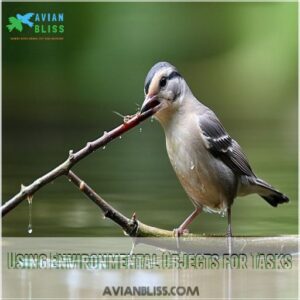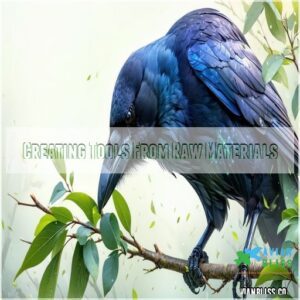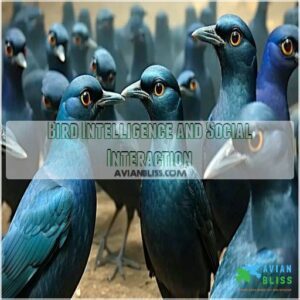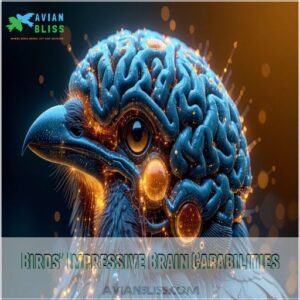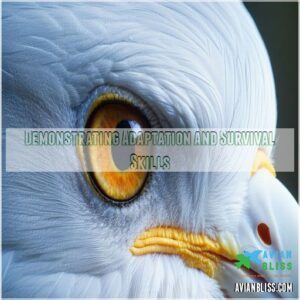This site is supported by our readers. We may earn a commission, at no cost to you, if you purchase through links.
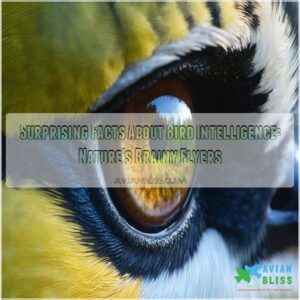
Imagine a magpie crafting a unique tool from a stick or a crow remembering thousands of food cache locations.
They’re not just birdbrained – these winged wonders can mimic human speech, demonstrate remarkable memory skills, and communicate with intricate social behaviors. Their tiny brains pack an incredible punch, processing information as efficiently as mammalian brains.
From woodpecker finches engineering specialized tools to ravens remembering human faces, these surprising facts about bird intelligence will make you see our avian friends in a whole new light. These feathered geniuses, winged wonders, and avian friends are truly remarkable.
Table Of Contents
- Key Takeaways
- Testing Bird Intelligence
- Tool Use and Modification in Birds
- Feats of Memory in Birds
- Mimicking Sounds and Speech
- Adapting to Human Environments
- Bird Intelligence and Social Interaction
- Birds’ Impressive Brain Capabilities
- Masterful Nests and Migrations
- Amazing Beak Adaptations and Color Displays
- Exceptional Abilities and Behaviors
- Frequently Asked Questions (FAQs)
- Are birds intelligent?
- Is a Bird’s Brain a good indicator of intelligence?
- Which birds are most intelligent?
- Are parrots intelligent?
- How does brain size affect intelligence in birds?
- Do birds have a high IQ?
- What bird has the highest IQ?
- What is a surprising fact about birds?
- What makes birds so intelligent?
- What is an example of a bird intelligence?
- Conclusion
Key Takeaways
- You’ll be amazed to learn that birds can solve complex problems and use tools with a creativity that rivals primates, demonstrating problem-solving skills that shatter traditional views of animal intelligence.
- You’ll discover that birds possess incredible memory capabilities, with some species like Clark’s nutcrackers remembering over 3,000 food cache locations, and parrots recognizing their owners decades later.
- You’ll be stunned by birds’ vocal learning abilities, with species like lyrebirds and African grey parrots not just mimicking sounds, but understanding context and even learning hundreds of human words.
- You’ll be surprised that bird brains, though small, are incredibly efficient, with dense neural networks that allow them to process information as effectively as mammalian brains and outperform young children on cognitive tests.
Testing Bird Intelligence
When you think of intelligent creatures, birds mightn’t be the first animals that come to mind,
but scientists are uncovering surprising evidence that challenges our assumptions.
You’ll be amazed to learn how researchers test bird intelligence through complex experiments that reveal remarkable cognitive abilities in these feathered geniuses.
Applying Learned Information to New Situations
Ever wondered how birds turn learning into pure problem-solving genius?
These feathered innovators constantly adapt their learned behaviors, showcasing remarkable creativity when facing new challenges.
From crafting custom tools to developing ingenious solutions, birds demonstrate breathtaking problem-solving skills that challenge our understanding of animal intelligence. problem-solving skills
Their ability to apply knowledge creatively proves they’re far from bird-brained. animal intelligence
Recognizing Self-Awareness
Pushing past simple responses, birds show mind-blowing self-awareness through the mirror test.
Eurasian magpies shatter expectations by recognizing their own reflections, hinting at deeper cognitive capabilities.
This is comparable to the impressive problem-solving skills of crows and ravens, as seen in their innovative tool-making abilities.
This breakthrough challenges our understanding of consciousness, revealing birds aren’t just feathered automatons but complex beings capable of empathy and social intelligence that’ll make you rethink everything you thought you knew about avian minds.
Identifying Individual Intelligence
Mirror tests reveal the intricate layers of bird intelligence, showing how these feathered brainiacs stand out.
Your understanding of avian cognitive abilities deepens when you explore their individual recognition skills:
- Unique vocal dialects distinguish bird identities
- Problem-solving varies between individual birds
- Social learning demonstrates remarkable adaptability
- Tool use reveals personalized strategies
Researchers are constantly amazed by how birds showcase their surprising individual intelligence, challenging everything we thought we knew about animal cognition.
Tool Use and Modification in Birds
You’ll be amazed to discover that birds aren’t just pretty feathered creatures, but masters of tool use that challenge our understanding of intelligence.
When you learn how woodpecker finches craft precise tools and New Caledonian crows engineer complex solutions, you’ll see these winged innovators in a whole new light.
Using Environmental Objects for Tasks
From unraveling bird intelligence, we now peek into their remarkable tool use strategies.
Woodpecker finches grab cactus spines to snag invertebrates, turning their environment into a smart survival toolkit.
Imagine hunting with just a twig – these feathered problem-solvers do exactly that, selecting materials and adapting objects to tackle challenges with impressive precision and creativity.
Creating Tools From Raw Materials
Regarding raw material manipulation, birds are nature’s MacGyvers.
New Caledonian crows craft intricate tools from leaves and sticks, showcasing incredible problem-solving skills; in fact, enthusiasts can find a wide range of products for crow toolmaking resources.
These clever avian engineers demonstrate an evolutionary advantage that rivals human tool creation.
Their innovative designs prove bird intelligence isn’t just about mimicry—it’s about genuine, creative problem-solving that’ll make you rethink everything you know about feathered friends.
Modifying Tools for Better Function
Building on their raw material crafting skills, woodpecker finches showcase remarkable bird intelligence through tool modification.
These clever avians adapt their tools with precision, revealing impressive problem-solving abilities.
Consider why tool modification matters:
- Increases foraging efficiency
- Demonstrates advanced cognitive skills
- Allows survival in challenging environments
- Highlights unexpected animal intelligence
Shortening sticks and customizing tools, these birds prove that innovation isn’t just a human trait.
Feats of Memory in Birds
You might be surprised to learn that birds possess memory capabilities that rival those of many mammals.
with some species remembering thousands of food cache locations for months.
Clark’s nutcrackers, for instance, can recall over 3,000 seed hiding spots with remarkable precision, demonstrating an extraordinary spatial memory that’ll make you rethink everything you thought you knew about feathered brains.
Caching and Retrieving Food
Ever wondered how birds become nature’s ultimate food-saving masterminds?
Clark’s nutcrackers are memory champions, hiding seeds in over 3,000 locations and retrieving them with astonishing precision months later.
Their caching strategies showcase remarkable spatial memory, allowing them to survive harsh winters by strategically storing and defending food supplies across complex landscapes.
Memorizing People and Places
After mastering food caching, birds reveal jaw-dropping memory skills that’ll blow your mind.
They also showcase their ability to learn and mimic complex bird song melodies.
Parrots can recognize their owners decades later, while ravens remember human faces for years.
Their bird intelligence shines through remarkable owner recognition and landmark-based memory strategies. Your feathered friends aren’t just pretty; they’re memory masters traversing complex spatial landscapes with incredible precision.
Demonstrating Object Recognition Memory
Most birds possess remarkable object recognition memory that’ll blow your mind!
Ravens can remember specific objects for up to three years, while Clark’s nutcrackers impressively track over 3,000 food cache locations with pinpoint accuracy.
Parrots excel at working memory, outperforming young children by quickly labeling and recalling objects, showcasing the stunning cognitive capabilities of these feathered geniuses.
Mimicking Sounds and Speech
You might be surprised to learn that some birds are master mimics, capable of reproducing everything from household sounds to complex human speech with astonishing accuracy.
From lyrebirds imitating chainsaws to African grey parrots understanding the meaning of words,
these feathered linguists will challenge everything you thought you knew about animal communication.
Vocal Learning and Imitation
Birdsong reveals a stunning world of vocal learning that’ll blow your mind.
These feathered linguists master communication through complex acoustic strategies:
- Developing intricate song dialects
- Adapting regional vocal variations
- Evolving sophisticated mimicry techniques
Vocal recognition isn’t just instinct—it’s a sophisticated skill that transforms chirps into sophisticated communication networks.
Birds don’t just tweet; they orchestrate complex linguistic performances that challenge our understanding of animal intelligence.
Mimicking Human Voices and Sounds
While parrots are vocal learning champions, you’ll be stunned by how closely some birds can mimic human voices.
Ravens, lyrebirds, and African greys don’t just copy sounds—they understand context and pitch, demonstrating remarkable vocal recognition skills.
From household appliance sounds to entire phrases, these feathered mimics showcase an intelligence that goes far beyond simple sound reproduction.
Artistic Expression Through Mimicry
Ever watched a lyrebird turn the forest into a living sound studio?
These avian maestros of vocal learning don’t just copy sounds—they create artistic soundscapes that blur the line between mimicry and performance.
From chainsaw roars to complex bird calls, lyrebirds and parrots showcase an extraordinary ability to transform mere imitation into a breathtaking display of creative intelligence.
Adapting to Human Environments
You’ll be amazed at how clever birds can be when they encounter human-made structures and resources.
From mastering bird feeders to creatively using nest boxes, these feathered geniuses show they’re not just surviving in our world—they’re thriving with remarkable intelligence.
Using Bird Feeders and Baths
Something as simple as a bird feeder reveals remarkable avian intelligence in adapting to human environments.
You’ll want to strategically place feeders where birds feel safe, offering a variety of food choices that attract different species.
High-quality water baths with clean, fresh water become critical meeting spots that showcase birds’ sophisticated social behaviors and problem-solving skills. This reveals avian intelligence and how birds adapt to human environments.
Utilizing Nest Boxes and Human Structures
Bird lovers know nest boxes aren’t just shelters—they’re clever adaptations showcasing urban avian intelligence.
Crows and sparrows quickly master these human-designed structures, turning them into prime real estate.
Your backyard becomes a laboratory of bird problem-solving, where feathered residents demonstrate remarkable habitat modification skills.
These innovative creatures transform simple boxes into sophisticated homes, revealing their adaptive genius. Nest boxes are more than just shelters; they are a testament to avian intelligence.
Demonstrating Intelligence Beyond Instinct
When ravens learn to open trash cans and cockatoos develop unique techniques for urban survival, they’re showcasing problem-solving skills that shatter traditional views of instinctual behavior.
Their complex communication and innovative tool use reveal a level of self-awareness that goes beyond simple survival.
These clever birds aren’t just adapting—they’re mastering human environments with remarkable intelligence.
Bird Intelligence and Social Interaction
You’ll be amazed by the sophisticated social intelligence of birds, where complex behaviors like partner recognition and strategic deception challenge our understanding of animal cognition.
From jackdaws identifying each other through unique contact calls to western scrub jays employing clever tactics to protect their food caches,
these feathered social strategists reveal a world of intricate communication and cunning survival skills.
Recognizing Partners and Offspring
Listening intently, emperor penguins crack the code of kinship through unique two-frequency calls, allowing parents to pinpoint their chicks in massive breeding colonies.
Jackdaws take recognition a step further, identifying individual companions through personalized contact calls that go beyond species-specific communication.
This remarkable ability showcases the depths of bird social intelligence and memory. Emperor penguins and Jackdaws.
Exhibiting Deception and Countermeasures
After recognizing their partners, some crafty birds take deception to a whole new level.
Western scrub jays pull off mind-blowing food theft tricks, re-hiding their caches multiple times to throw off potential thieves.
These clever avian strategists showcase advanced cognitive abilities, proving that cache hiding isn’t just about survival – it’s a sophisticated game of social intelligence and predator avoidance.
Engaging in Complex Social Behaviors
From intricate social landscapes emerge fascinating insights into bird intelligence, where group dynamics reveal shocking cooperation levels.
Western scrub jays masterfully employ deception tactics, re-hiding food to confuse potential thieves.
These social rules showcase remarkable cognitive abilities, demonstrating how birds navigate complex mate selection and communication strategies with surprising finesse, challenging our understanding of avian social interaction. Bird intelligence is revealed through cooperation levels.
Birds’ Impressive Brain Capabilities
You’ll be amazed to learn that birds possess brain power that rivals mammals, with densely packed, highly efficient neurons that make their brains surprisingly sophisticated.
Despite their small size, these feathered geniuses can outperform young children in memory tests and demonstrate complex problem-solving skills.
avian intelligence will make you rethink everything you thought you knew about bird brain power.
Having Large Brains Relative to Body Size
You might think bird brains are tiny, but they’re packing serious cognitive punch.
Despite limited skull space from flight requirements, birds like crows and parrots boast impressive brain-to-body ratios that challenge old "birdbrain" stereotypes.
Their compact neural networks reveal remarkable brain size adaptations, suggesting evolutionary pressures have fine-tuned avian intelligence through efficient design rather than sheer volume.
Possessing Highly Efficient Brain Cells
Their compact brains pack a powerful punch!
While smaller than mammals, bird brains boast incredible neuron density that maximizes cognitive processing, which can be further explored through research and products related to avian neuron density studies.
Packed with efficiently organized cells, avian brain structures leverage evolutionary advantages that turn size limitations into strengths.
These neural networks fire with remarkable precision, proving that big intelligence doesn’t always mean a big brain – sometimes, it’s all about how you wire it.
Demonstrating Comparable Intelligence to Mammals
Packing neural density into small packages, birds prove brain size isn’t everything regarding intelligence.
Parrots and crows showcase problem-solving skills rivaling primates, demonstrating remarkable cognitive flexibility.
Their social complexity and self-recognition challenge traditional views of animal intelligence, revealing emotional intelligence that goes toe-to-toe with mammals’ sophisticated cognitive abilities. problem-solving skills and emotional intelligence. cognitive flexibility
They also exhibit complex communication systems through vocal and visual signals.
Masterful Nests and Migrations
You’ll be amazed by the architectural prowess and navigational skills of birds, from the intricate bowers of bowerbirds to the epic migrations of Arctic-breeding species.
Discover how these feathered travelers construct masterful nests.
jaw-dropping journeys spanning thousands of kilometers, showcasing intelligence that’ll make you rethink everything you thought you knew about our avian friends.
Constructing Intricate Nests and Bowers
Some birds turn nest building into an art form, with the Vogelkop bowerbird leading the innovation pack.
These feathered architects craft intricate structures using diverse materials, showcasing remarkable bird intelligence.
Their nest construction techniques reveal evolutionary advantages, transforming simple shelter into a complex masterpiece of structural beauty and strategic design.
Embarking on Long-Distance Migrations
Yearly, the Siberian plover begins an incredible 20,000-kilometer migration odyssey, zigzagging between the Arctic and South Africa.
Overcoming treacherous landscapes, these feathered adventurers surmount desert crossings, water barriers, and human-altered terrains.
Their journey demands precision in route selection, energy conservation, and timing, showcasing remarkable bird navigation skills that push the boundaries of avian intelligence and survival.
Demonstrating Adaptation and Survival Skills
When survival demands creativity, birds become nature’s ultimate problem-solvers.
Their resourcefulness shines through remarkable adaptations:
- Clever camouflage helps them dodge predators
- Migration routes reveal intricate navigation skills
- Nest-building demonstrates exceptional problem-solving techniques
From arctic tundras to tropical forests, these feathered survivors continually outsmart challenges, proving that bird intelligence goes far beyond simple instinct.
Amazing Beak Adaptations and Color Displays
You’ll be amazed by the stunning ways birds use their beaks and feather colors to communicate, attract mates, and survive in the wild.
From the vibrant plumage of the Wilson’s bird-of-paradise to the massive beak of the toco toucan, these remarkable adaptations reveal the incredible intelligence and creativity of our feathered friends.
Exhibiting Vibrant Plumage and Courtship Displays
Birds paint their love stories through breathtaking plumage variations that scream "pick me!" Male Wilson’s bird-of-paradise rocks a showstopping red and iridescent blue ensemble, turning courtship into a high-stakes fashion show.
| Bird Species | Plumage Complexity | Mating Success | Evolutionary Wow Factor |
|---|---|---|---|
| Wilson’s B-o-P | Extreme | sky-high | 10/10 |
| Superb Lyrebird | Mind-blowing | astronomical | 9/10 |
| Peacock | Legendary | off the charts | 8/10 |
| Bowerbird | Artistic | remarkable | 9/10 |
Nature’s runway isn’t just about looks—it’s survival’s most colorful strategy.
Possessing Unique Beak Structures and Functions
Ever marveled at how a toco toucan’s massive beak defies gravity? These incredible bird tools are nature’s Swiss Army knives, perfectly adapted for survival.
- Lightweight yet strong structural design
- Vibrant colors that scream "look at me!"
- Precision foraging across diverse landscapes
- Shape-shifting functionality for multiple tasks
From woodpecker finches wielding cactus spines to toucan beaks accessing distant fruits, these appendages aren’t just for show – they’re survival game-changers.
Utilizing Beaks for Communication and Drumming
Some avian species transform their beaks into remarkable communication tools beyond simple eating and drinking.
Through intricate drumming patterns and vibrant beak colors, birds create complex sound production mechanisms that rival sophisticated musical instruments.
These specialized vocalizations help birds communicate territorial boundaries, attract mates, and signal important social information across diverse avian species, often incorporating unique songs and calls to claim territory and attract mates.
These specialized vocalizations help birds communicate territorial boundaries, attract mates, and signal important social information across diverse avian species.
Exceptional Abilities and Behaviors
You’ll be amazed by the extraordinary intelligence of birds that challenges our understanding of animal cognition.
From mimicking complex sounds to solving intricate problems, these feathered geniuses will make you rethink everything you thought you knew about avian capabilities.
Laying Large Eggs Relative to Body Size
Exploring avian egg-cellence reveals mind-blowing strategies for survival among our feathered friends.
The kiwi bird takes egg size to extraordinary limits, laying eggs that challenge every biological expectation. This unique reproductive ability is made possible because, unlike some baby birds that aren’t yet developed enough to reproduce, kiwi birds reach sexual maturity stages.
- Large eggs boost hatchling survival chances
- Egg size represents complex evolutionary adaptation
- Kiwi eggs measure up to 25% of female’s body
- Unique reproductive conditions drive egg size
- Single egg strategy maximizes parental investment
Mimicking Various Sounds and Voices
After laying eggs that dwarf their body size, kiwis might seem impressive.
But wait until you hear birds’ vocal talents! Lyrebirds and mockingbirds are nature’s sound masters, mimicking everything from chainsaw roars to household appliances.
Their vocal learning skills showcase bird smarts that’ll blow your mind, revealing how these feathered performers craft unique dialects and communication patterns that rival human creativity.
Exhibiting Intelligence and Adaptation in Everyday Life
Ever wondered how birds turn everyday challenges into opportunities? Their problem-solving skills reveal incredible resourcefulness in changing environments.
- Managing urban landscapes with remarkable adaptability
- Developing innovative survival strategies amid human expansion
- Mastering social dynamics through intelligent communication
Birds also benefit greatly from bird intelligence toys that stimulate their cognitive abilities.
Crows, in particular, demonstrate extraordinary intelligence by ingeniously overcoming obstacles in their path.
Frequently Asked Questions (FAQs)
Are birds intelligent?
You might wonder if birds are just feathered lightweights, but science says they’re cognitive powerhouses.
Parrots learn hundreds of words.
Crows craft tools.
Some birds can solve problems that would stump young children.
Is a Bird’s Brain a good indicator of intelligence?
Don’t judge a bird’s smarts by brain size alone!
Dense neural packing and efficient connections mean small avian brains can outperform larger mammalian counterparts in problem-solving, tool use, and complex cognitive tasks.
Which birds are most intelligent?
Cracking the intelligence code, crows and African grey parrots reign supreme among avian geniuses.
They’ve mastered tool use, complex problem-solving, and language skills.
They’ve mastered skills that’ll make your jaw drop faster than a bird diving for prey.
Are parrots intelligent?
Hold onto your hat—parrots are brain wizards that’ll blow your mind!
These feathered geniuses can learn hundreds of words, understand complex concepts, and outperform young children in memory tests.
making them cognitive superstars of the animal kingdom.
How does brain size affect intelligence in birds?
You’d be surprised that bird brain size doesn’t limit intelligence.
Compact, neuron-dense brains help birds like parrots and crows punch way above their weight.
quality trumps size in the brainy bird world.
Do birds have a high IQ?
Regarding bird brains, don’t ruffle your feathers!
Birds like parrots and crows pack serious cognitive punch.
They outperforming young children in memory tests and demonstrating remarkable tool use, problem-solving skills, and adaptive intelligence.
What bird has the highest IQ?
If you’re wondering which feathered genius takes the crown, African grey parrots and New Caledonian crows are neck and neck.
These brainy birds can solve complex problems, use tools, and even understand human language with remarkable precision.
What is a surprising fact about birds?
Did you know that New Caledonian crows craft their own tools, shaping leaves and sticks with precision that would make a skilled carpenter proud?
These feathered geniuses can solve complex problems with creativity that’ll blow your mind.
What makes birds so intelligent?
You’ve got a brain packed with more potential than you might think.
Birds like crows and parrots demonstrate remarkable intelligence.
They show this through tool use, complex social behaviors, and memory skills that put humans to shame.
What is an example of a bird intelligence?
New Caledonian crows reveal mind-blowing intelligence by crafting custom tools from leaves and sticks.
They demonstrate problem-solving skills that rival some primates.
They’ll literally shape tools to reach food, showing brainpower that’ll blow your mind.
Conclusion
As you soar through the bird intelligence universe, you’ll marvel at these feathered geniuses that challenge our understanding of cognition.
The surprising facts about bird intelligence reveal a sphere where tiny brains pack incredible problem-solving skills, tool use, and social complexity.
From memory mastery to vocal mimicry, birds demonstrate remarkable cognitive abilities that rival mammals.
They’re not just winged creatures, but intelligent beings that continue to astound scientists and nature enthusiasts alike.


